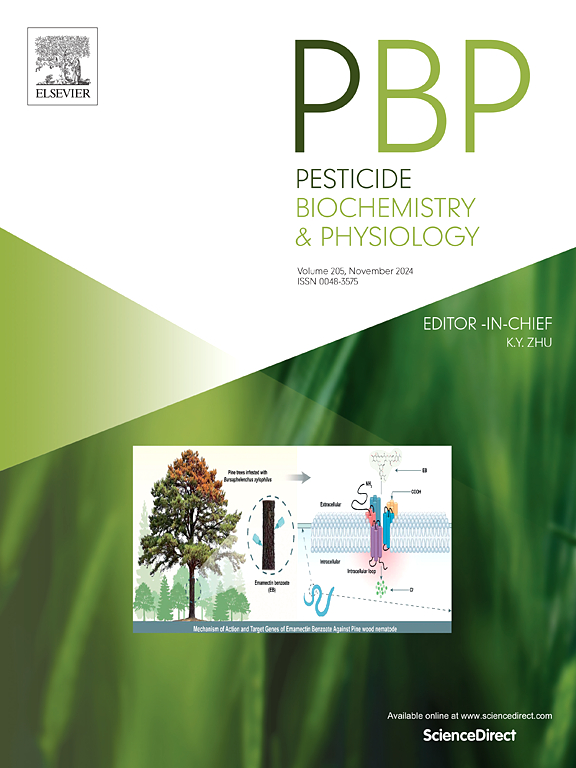Altered Octopamine synthesis impairs tyrosine metabolism affecting Helicoverpa armigera vitality
IF 4.2
1区 农林科学
Q2 BIOCHEMISTRY & MOLECULAR BIOLOGY
引用次数: 0
Abstract
Tyramine β-hydroxylase (TβH) is a key enzyme in the biosynthesis of octopamine (OA), a vital neurohormone in invertebrates. This study explores the expression patterns and functional role of Helicoverpa armigera TβH (HaTβH) across various tissues and developmental stages. HaTβH expression was highest in the head and adult male stages, reflecting tissue-specific and developmental regulation. HaTβH silencing significantly increased locomotion and decreased feeding behavior. OA supplementation in silenced insects or HaTβH overexpression showed a contrary effect on locomotory and feeding behavior. In silico screening and inhibitory assays identified tomatidine, a tomato-derived metabolite, as a potent HaTβH inhibitor with strong binding affinity. In vivo bioassays confirmed tomatidine's inhibitory effects, reducing feeding and increasing mortality in H. armigera. Modulation in HaTβH expression or activity disturbs the tyrosine metabolic pathway, with altered levels of tyramine, octopamine, and dopamine. These results highlight HaTβH as a key regulator of OA biosynthesis, influencing insect feeding, locomotion, and overall survival. The present study also introduces tomatidine as a potential candidate for insect control, given its ability to disrupt HaTβH function. This work provides new insights into the physiological roles of HaTβH and offers promising avenues for developing targeted pest management strategies.

求助全文
约1分钟内获得全文
求助全文
来源期刊
CiteScore
7.00
自引率
8.50%
发文量
238
审稿时长
4.2 months
期刊介绍:
Pesticide Biochemistry and Physiology publishes original scientific articles pertaining to the mode of action of plant protection agents such as insecticides, fungicides, herbicides, and similar compounds, including nonlethal pest control agents, biosynthesis of pheromones, hormones, and plant resistance agents. Manuscripts may include a biochemical, physiological, or molecular study for an understanding of comparative toxicology or selective toxicity of both target and nontarget organisms. Particular interest will be given to studies on the molecular biology of pest control, toxicology, and pesticide resistance.
Research Areas Emphasized Include the Biochemistry and Physiology of:
• Comparative toxicity
• Mode of action
• Pathophysiology
• Plant growth regulators
• Resistance
• Other effects of pesticides on both parasites and hosts.

 求助内容:
求助内容: 应助结果提醒方式:
应助结果提醒方式:


